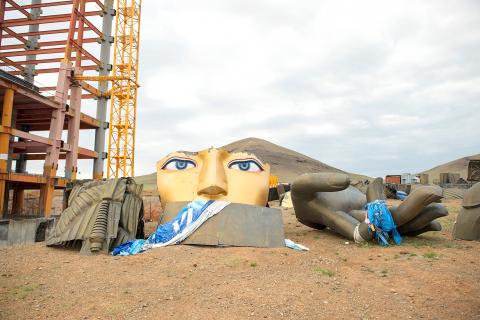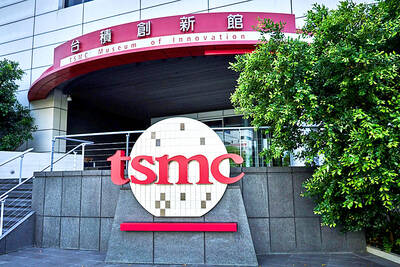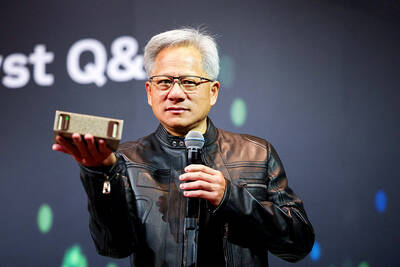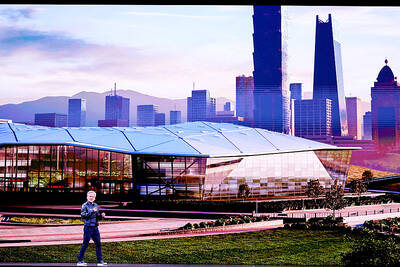On a barren patch of land outside Mongolia’s capital, a former herder guards a half-finished pedestal and abandoned golden Buddha’s head — testament to the money problems keeping Buddhism from flourishing in the country.
When 68-year-old Tsegmid Lunduv, a long-time nomad, was hired to patrol the spot in 2013, the project seemed full of promise: a proposed sprawling complex of meditation centers and spiritual retreats, tucked into the rolling steppes outside Ulan Bator and under the spiritual guidance of the Dalai Lama.
However, two years ago construction was suspended pending additional funding, leaving two partially built legs, the unattached head and a hand with fingers curled into the gesture for teaching and understanding.

Photo: AFP
Only Lunduv, his wife, grandson and their puppy were standing sentry on a recent visit to the holy site-to-be.
“Once the project comes to fruition, all of Mongolia’s troubles will go away,” said Lunduv, a portly man with a tattered white tunic and a gap-toothed smile. “It will usher in a new era.”
One of the project’s main financial backers, Genco Group, is owned by Mongolian President Khaltmaa Battulga, who took office in July and must now navigate the country out of its maze of debt with a US$5.5 billion IMF-led bailout.
Buddhism has returned to prominence after being quashed over years of Soviet control, with more than half of the population now identifying as Buddhist, official figures showed.
However, the debt-laden country’s money troubles have severely limited the infrastructure needed for the religion to fully flourish, with monasteries lacking proper residential facilities for monks.
Buddhist traditions in Mongolia predate the rule of Genghis Khan, who established close ties with a Tibetan Buddhist school.
Khan’s grandson Kublai Khan even commissioned his spiritual guru to create an easier form of the Tibetan script to be used in the territories under his command.
However, even under Tibetan Buddhism’s heavy influence, Mongolians gave the religion their own cultural touch inspired by shamanistic invocations using vodka; Mongolian Buddhists consider the Russian liquor sacred, just as wine is to Christians.
Additionally, as the Mongolian Empire suffered from a population shortage, the Dalai Lama at the time permitted Mongolian monks to marry and have children — although mistresses remained strictly forbidden.
The biggest challenge to Mongolian Buddhism came during the country’s years as a Soviet satellite state, from 1924 to the early 1990s, when the Arts Council of Mongolia estimates that more than 1,250 monasteries and temples were demolished and countless religious artifacts lost.
Monks, if they were not killed, were forced to marry.
“After 60 years of oppression, [Mongolia’s] monkhood was pretty much destroyed,” said Glen Mullin, an expert on Tibetan Buddhism.
Only one monastery, Ulan Bator’s Gandantegchinlen Monastery, was permitted to stay open during that period to support the Soviets’ claims of religious tolerance.
In 1996, in a newly democratic Mongolia, 18-year-old Batchunuun Munkhbaatar left his countryside home in central Tuv Province to join the monastery in the capital.
It was home to just 25 monks then, but Munkhbaatar stayed and immersed himself in the Buddhist practice. Now 800 monks belong to the monastery, the country’s largest.
“During the [Soviet era], the party controlled the faith of the people, but they couldn’t control their inner devotion,” Munkhbaatar said, adding that his grandfather “didn’t quit his chanting or prayers, even during the communist time.”
“He would do all these things behind locked doors. If someone approached the house, the dog would bark and he’d put away his scriptures and images of Buddha,” he added.
The revival of Buddhism has been a sticky issue for the Mongolian government, which pledged not to extend any more invitations to the Dalai Lama after his visit to Ulan Bator in November last year angered China, its neighbor and biggest trade partner.
There are now 3,500 monks across the country, said Munkhbaatar, who handles Gandantegchinlen’s foreign relations.
Mullin expects these numbers to swell as the first wave of young Mongolian Buddhists return from studying in India and Tibet.
Back in their homeland, they will face a tough financial reality.
“Most Mongolian monasteries do not offer the proper conditions for monks to actually live in them,” said Vesna Wallace, a religious studies scholar at the University of California, Santa Barbara. “Monasteries receive funding only when they are building something, not for their day-to-day operations. They rely on donations, so many monks are quite poor and have had to marry, because they can’t live off their own income.”
At the site of the Grand Maitreya project, Lunduv has faith the money will come.
The project’s official Facebook page said in March that the first building phase would be completed by the end of this summer if US$25,000 in donations was raised.
Every morning, Lunduv pours a freshly brewed cup of tea out onto the field around the construction area as a prayer to the gods.
“It will be finished,” Lunduv said. “The government will support us, because our country is a Buddhist country.”
“Our history is tied to our religion,” he added.

SEEKING CLARITY: Washington should not adopt measures that create uncertainties for ‘existing semiconductor investments,’ TSMC said referring to its US$165 billion in the US Taiwan Semiconductor Manufacturing Co (TSMC, 台積電) told the US that any future tariffs on Taiwanese semiconductors could reduce demand for chips and derail its pledge to increase its investment in Arizona. “New import restrictions could jeopardize current US leadership in the competitive technology industry and create uncertainties for many committed semiconductor capital projects in the US, including TSMC Arizona’s significant investment plan in Phoenix,” the chipmaker wrote in a letter to the US Department of Commerce. TSMC issued the warning in response to a solicitation for comments by the department on a possible tariff on semiconductor imports by US President Donald Trump’s

‘FAILED EXPORT CONTROLS’: Jensen Huang said that Washington should maximize the speed of AI diffusion, because not doing so would give competitors an advantage Nvidia Corp cofounder and chief executive officer Jensen Huang (黃仁勳) yesterday criticized the US government’s restrictions on exports of artificial intelligence (AI) chips to China, saying that the policy was a failure and would only spur China to accelerate AI development. The export controls gave China the spirit, motivation and government support to accelerate AI development, Huang told reporters at the Computex trade show in Taipei. The competition in China is already intense, given its strong software capabilities, extensive technology ecosystems and work efficiency, he said. “All in all, the export controls were a failure. The facts would suggest it,” he said. “The US

The government has launched a three-pronged strategy to attract local and international talent, aiming to position Taiwan as a new global hub following Nvidia Corp’s announcement that it has chosen Taipei as the site of its Taiwan headquarters. Nvidia cofounder and CEO Jensen Huang (黃仁勳) on Monday last week announced during his keynote speech at the Computex trade show in Taipei that the Nvidia Constellation, the company’s planned Taiwan headquarters, would be located in the Beitou-Shilin Technology Park (北投士林科技園區) in Taipei. Huang’s decision to establish a base in Taiwan is “primarily due to Taiwan’s talent pool and its strength in the semiconductor

French President Emmanuel Macron has expressed gratitude to Hon Hai Precision Industry Co (鴻海精密) for its plan to invest approximately 250 million euros (US$278 million) in a joint venture in France focused on the semiconductor and space industries. On his official X account on Tuesday, Macron thanked Hon Hai, also known globally as Foxconn Technology Group (富士康科技集團), for its investment projects announced at Choose France, a flagship economic summit held on Monday to attract foreign investment. In the post, Macron included a GIF displaying the national flag of the Republic of China (Taiwan), as he did for other foreign investors, including China-based